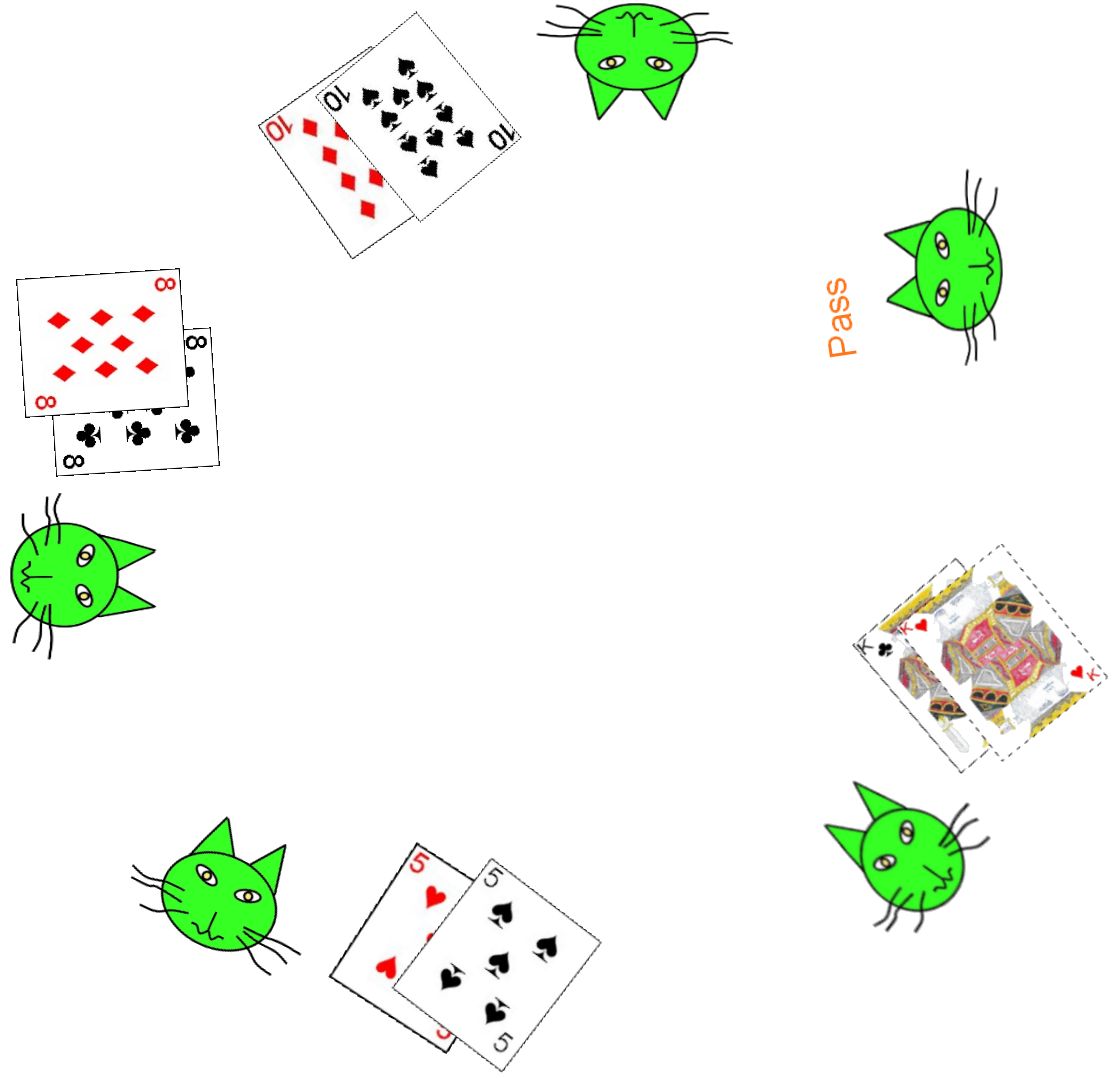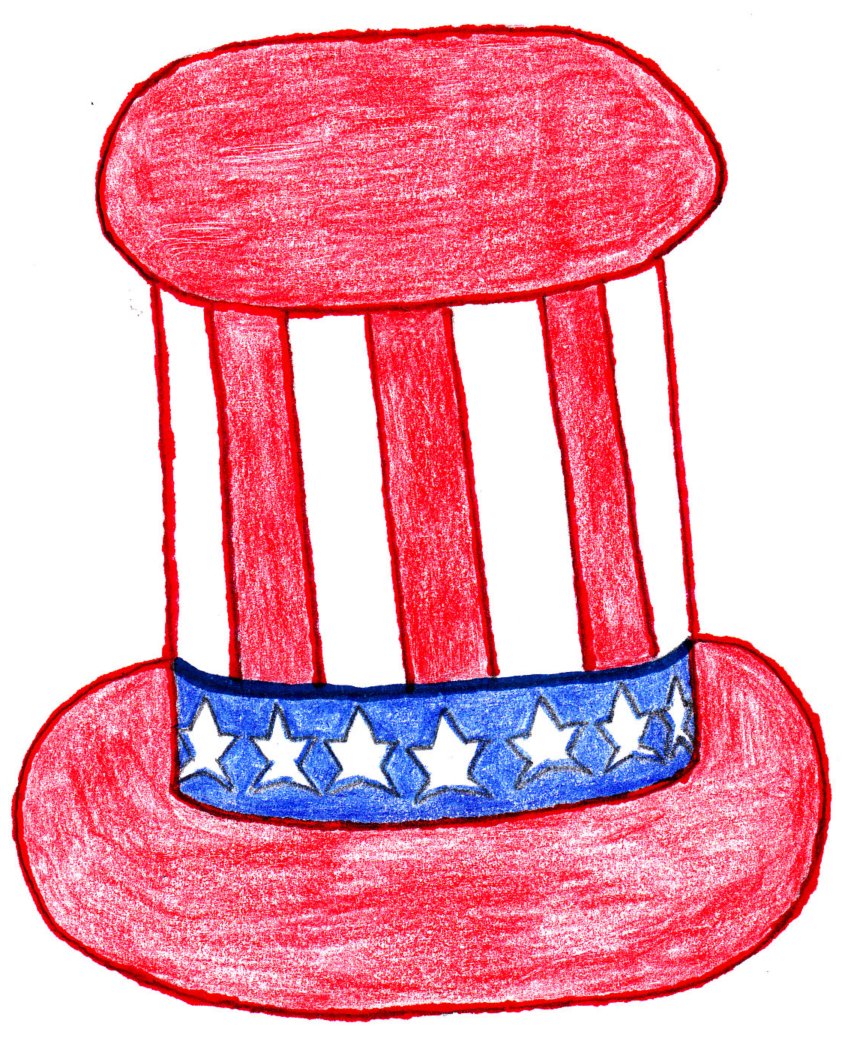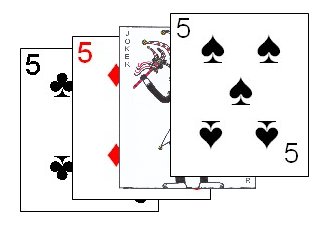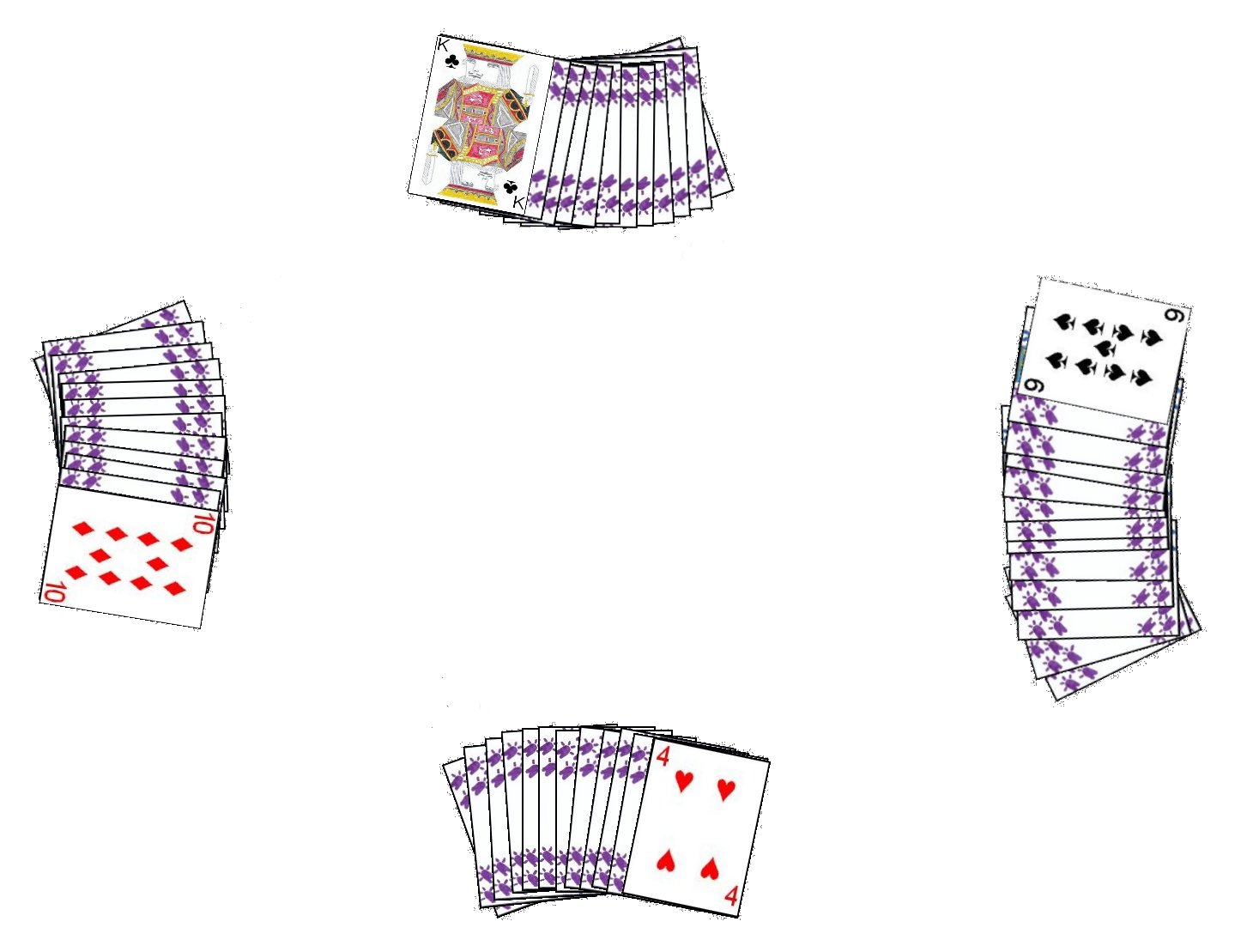Similar to Big Two and other games of this ilk, the object is to be the first player to rid themselves of all cards in the hand before the opponents. President uses the standard 52 card deck. The ranking of the cards for this game are as follows, from high to low; 2, Ace, King, Queen, Jack, 10, 9, 8, 7, 6, 5, 4, 3. There is no separate suit ranking in President as there is in some other games of the same type. The game is played by from 4 to 10 players. With 7 or more players, the game is best played using two standard 52 card decks shuffled together.
 For the first hand, the standard methods used to determine the first dealer is to have all players draw a card from a shuffled deck. If any players have cards of the same rank, they should draw new cards until they draw a card that do not match any other card drawn. The players may also initially select seats at the table in the order of high to low card drawn. As this game features special Social Ranking during the game, for the first hand the player drawing the highest card is the President and the player drawing the lowest is the Scum. Alternatively, the titles may not be assigned until the end of the first hand. For the second and subsequent hands, these titles will be won or lost depending on a players finishing order during play of the hand.
For the first hand, the standard methods used to determine the first dealer is to have all players draw a card from a shuffled deck. If any players have cards of the same rank, they should draw new cards until they draw a card that do not match any other card drawn. The players may also initially select seats at the table in the order of high to low card drawn. As this game features special Social Ranking during the game, for the first hand the player drawing the highest card is the President and the player drawing the lowest is the Scum. Alternatively, the titles may not be assigned until the end of the first hand. For the second and subsequent hands, these titles will be won or lost depending on a players finishing order during play of the hand.
However, after the first hand, the next dealer and new seating positions are instead determined by the order in which the players are able to deplete all cards from their hands (as described below) in the previous hand.
Each turn rotates in a clockwise rotation from player to player around the table. The dealer deals the cards, starting with the player to his immediate left, dealing each player one card in a continuing clockwise rotation until the entire deck is dealt. Some players may receive one more card than others which is normal in this game. For the first hand, the player who holds the 3 of clubs plays first. He also must use this card in his first play. This play may consist of from one to four cards of the same numerical rank placed in the center of the table. The next player in turn then attempts to beat this play with a combination of his own that contains the same number of cards, but in a higher rank. If that player is unable (or chooses not) to make a play consisting of the same number of cards in a higher rank, they must pass with the turn then passing to the next player in rotation. If that player is able to play a higher combination, he may then do so (but may choose to pass instead), with the next player in turn then trying to beat the new high combination. This continues around the table until a player either plays his last card or no other players can beat a combination so played.
In the event that all other players pass after a play, the Scum removes all the played cards from the table putting them aside, and then the player who made the high play starts a new combination of from 1 to 4 equally ranked cards from his hand in which the other players again attempt to beat. The game continues in this way until a player plays the last card in his hand. When this happens, that player drops from the hand, being considered the first winner and earning the title President. The remainder of the players continue playing in the same way until the next player runs out of cards who also drops from the hand and is considered the second winner and Vice President. The play continues until all but one player have played their last card, with the last player still having cards called the Scum. At this point, scoring is then performed for the hand. The first winner, or President earns two points and the Vice President earns one point. The Scum loses two points, and the second to last player to run out of cards, called the Vice Scum, loses one point. All other players neither gain or lose points.
Based on the specific order in which the players run out of cards during the hand, they are given a temporary social status for the next hand. The specific titles used depend on the number of players used and may vary greatly from place to place (see below for other commonly used hierarchies used for titles in this game). The following chart shows a common ranking that might be used with 9 participants. For less than 8 players, some of the middle ranks (which neither gain or lose points) are removed. For example, with five players, you would have the President, Vice-President, Average Joe, Vice-Scum and Scum and with four players you might have President, Vice-President, Vice Scum and Scum. For more than 8 players, any number of mid ranked Average Joes (or similar ranks) can be added as necessary.

|
|
In addition to the title and possible points earned from the hand, there are other effects based on a player's assigned rank. The President deals the next hand, while the Scum gathers all the cards and shuffles in preparation for the Presidents deal. At the end of each hand, everyone must get up from the table and the President makes their choice of seats at the table. The remaining players then take seats in a clockwise rotation in descending rank of their current social status. Often, to add fun to the game a variety of different chairs are placed at the table, of varying levels of comfort, for the players to seat themselves at in order of rank. Some games even feature hats or other accessories the player in the role of the different titles must wear or use. In addition, for the next hand, the Scum must give the President his two highest ranked cards in exchange for any two cards of the Presidents choice. Similarly the Vice Scum must give the player who earned the title of Vice President his best ranked card in exchange for one card of the Vice Presidents choice. The President plays the first combination to the next hand and may play any valid combination. The first player to amass 11 points is declared the game winner.
Differing Titles: As this game is played in many localities and social groups around the world, it is not hard to imagine that there would be a large number of differing groups of titles used to assign to the players. A few such hierarchies are listed below, but this is by no means an exhaustive list.
- In many European countries, for instance, social standings equivalent to titles of royalty might be used. This hierarchy might include the following; Emperor (or Empress), King (Queen), Duke (Duchess), Earl (Countess), Serf, Peasant).
- In some places the titles might be more related to titles in an industrialized society, such as Boss, Supervisor, Foreman, Worker, Janitor.
- In some games, players may use an abridged form of the actual United States Presidential line of succession. Thus, some of the following titles might be used; President, Vice-President, Speaker of the House, Secretary of State, Secretary of the Treasury, Secretary of Defense, Attorney General, Secretary of the Interior, Citizen.
 President with Jokers: In some games, President is played with the addition of two Jokers making a 54 card deck. In most decks of cards, the Jokers are distinguishable from each other, usually one is in color and the other black and white which indicates their relative ranking during the game. A player who has a Joker in their hand may use it in one of two ways:
President with Jokers: In some games, President is played with the addition of two Jokers making a 54 card deck. In most decks of cards, the Jokers are distinguishable from each other, usually one is in color and the other black and white which indicates their relative ranking during the game. A player who has a Joker in their hand may use it in one of two ways:
- As the highest ranked card in the game, even outranking the twos. When two individual Jokers might be played to the same trick by two differing players, the color Joker is considered to outrank the black and white Joker.
- A Joker can be used in a played combination to represent any other card. Thus a player could create a set of four 5's using three natural 5's and one Joker. However, under no circumstances can a single combination ever contain more than four cards.
Revolutions: Some players allow the use of Revolutions in the game. A Revolution occurs anytime any player starts a series of plays with four cards of the same rank. When this occurs, the current card ranking in the hand is reversed, starting with the very next play. Thus, the first time a revolution is played, the ranking of the cards in the hand would become (from high to low): 3, 4, 5, 6, 7, 8, 9, 10, Jack, Queen, King, 2. The next revolution would then reverse this order again, back to the normal ranking and each Revolution played during the hand would continue to reverse the ranking again. If special headgear is being used in the game, these are usually turned inside-out during a revolution.
Reelection Bonus: Another optional rule used concerns if a player manages to retain the title of President. Any player who manages to earn the title of President for three hands in succession is given the opportunity to make up their own rule. These are usually silly rules that have little or no affect on the actual gameplay. For each additional hand in succession that this player retains the title of President, they may make one more additional rule.
One Deuce Wins: In some games, a single deuce can beat any other played combination regardless of how many cards comprise the combination. This automatically beats all other combinations and the player who played this card can begin a new series with a combination of their choice.
Equal Plays: When using this variant rule, in addition to playing a higher set of the same number of cards, a player could also play a set consisting of the same number of cards of the same rank. When this does happen, the turn for the next player is skipped.
 Exposed Card Hands: In this version, after the first hand, a number of hands equal to the number of players is dealt to the center of the table. One card of each of these hands is dealt face up. Each player then selects their hand of choice in order of their title. Thus, the President gets first pick of hands, the Vice President the second choice and so on until every player has selected a hand and play begins.
Exposed Card Hands: In this version, after the first hand, a number of hands equal to the number of players is dealt to the center of the table. One card of each of these hands is dealt face up. Each player then selects their hand of choice in order of their title. Thus, the President gets first pick of hands, the Vice President the second choice and so on until every player has selected a hand and play begins.
Black Market: In this version, the current president may (but is not required to) declare Black Market trading after the deal but before the actual play of a hand begins. When Black Market trading is in effect, the players may trade cards amongst themselves before the play of the hand commences. Any player wanting to trade would state a specific rank of card and ask if any other player wants to trade. Another player would then state what card they might want to trade and if both players agree to the trade the cards would change hands. This trading may occur until all players have completed their trades after which the play of the hand would begin.
Untouchable Cards: When this optional rule is adhered to, only the Scum can shuffle, cut and deal the cards. Once a player's hand is distributed to him, he may touch his own cards. In addition, no player may intentionally touch any of the played cards in the center except the player in the Scum position who is supposed to clear all cards from the center at the completion of a play. If anyone else does touch the cards, the player so doing is automatically assigned the Scum role on the next hand.
Dai Hin Min: This Japanese game is also commonly known as Dai Fugo. It is probable that this game was the direct precursor to the game President described above. This game is played very similarly to President with a few exceptions.
This game uses the standard 52 card deck and the same ranking of the cards as the game of President (from high to low); 2, Ace, King, Queen, Jack, 10, 9, 8, 7, 6, 5, 4, 3. The deal and play of the hand is in a counter-clockwise direction which differs from the game President. The entire deck should be dealt out, with a few players possibly getting one extra card which is normal. After the first hand, the deal should be arranged in such a way, however, that the extra cards are dealt to the players with the lowest game social ranks from the previous hand. This can usually be accomplished by starting the deal with the player immediately to the right of the current high ranked player. The first player can be determined in a variety of ways including cutting for high card.
As in the standard game, the object is to be the first player to completely rid of his hand of cards. This first player may play any valid combination to the table. As in President, this combination can be from one to four cards all of the same suit.
The next players will then attempt to beat the last combination played. If a player cannot beat this last combination they must pass. If all the other players pass after a combination, the player who played that last combination can start a new combination of his choice.
The titles used in this game are shown in the following table:
| Finishing Order in Hand | Title | Points Earned |
|---|---|---|
| First | Daifugo | 2 |
| Second | Fugo | 1 |
| Third | Heimin | 0 |
| Fourth | Hinmin | 0 |
| Fifth | Daihinmin | 0 |
An English language equivalent from the standard game might be as follows: Daifugo - President, Fugo - Vice President, Heimin - Average Joe, Hinmin - Vice Scum, Daihinmin - Scum. If there are less than five players some of the middle titles would be removed. After each hand, the players all get up, with the highest ranked player selecting his seat first. Each other player must then seat themselves in order of rank in a clockwise rotation after this player. The lowest ranked player must give his two highest cards to the highest ranked player on the next hand and the second lowest ranked player must give his highest card to the second highest ranked player. These players then give any replacement cards of their choice to the lower ranked players. The highest ranked player also begins play on the next hand. The winner is the first player at the end of a hand to reach a certain specified total, such as 11 points.
Quick Clears: This variation allows a player, in certain circumstances to play out of turn. If one player plays a set of one or more cards and another player has the remaining cards of the same denomination to make a complete set of four, this player may immediately play them, even out of turn. When this happens, this is considered the end of the current round and the player who played the second set of cards may begin with any valid play of their choice.
Multiple Decks: President can also be played with additional decks to accommodate more players. With more than 8 players a second deck should be added making a large 104 card deck. When playing with multiple decks, combinations of higher than 4 cards are possible. In addition, in order to beat a previous combination, a combination played must consist of a higher ranked combination (combinations of the same number of cards of the same rank are usually not allowed). When using multiple decks, since there will be more than one three of Clubs, the first player to play it to the center of the table in a combination has the privilege of having the first turn.